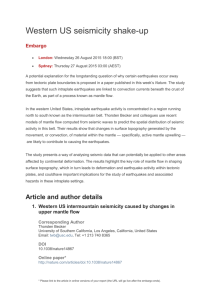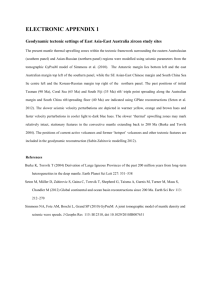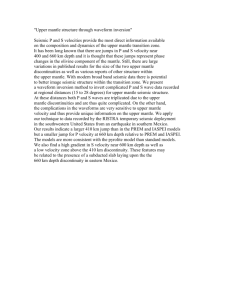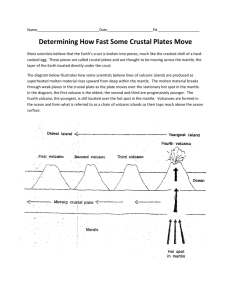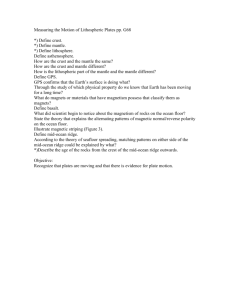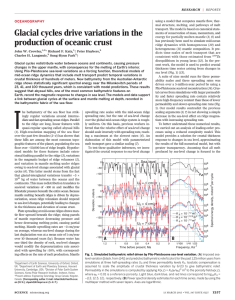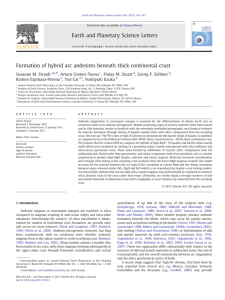A Decade of Imaging Basaltic Magmatism: Evidence for Lithospheric
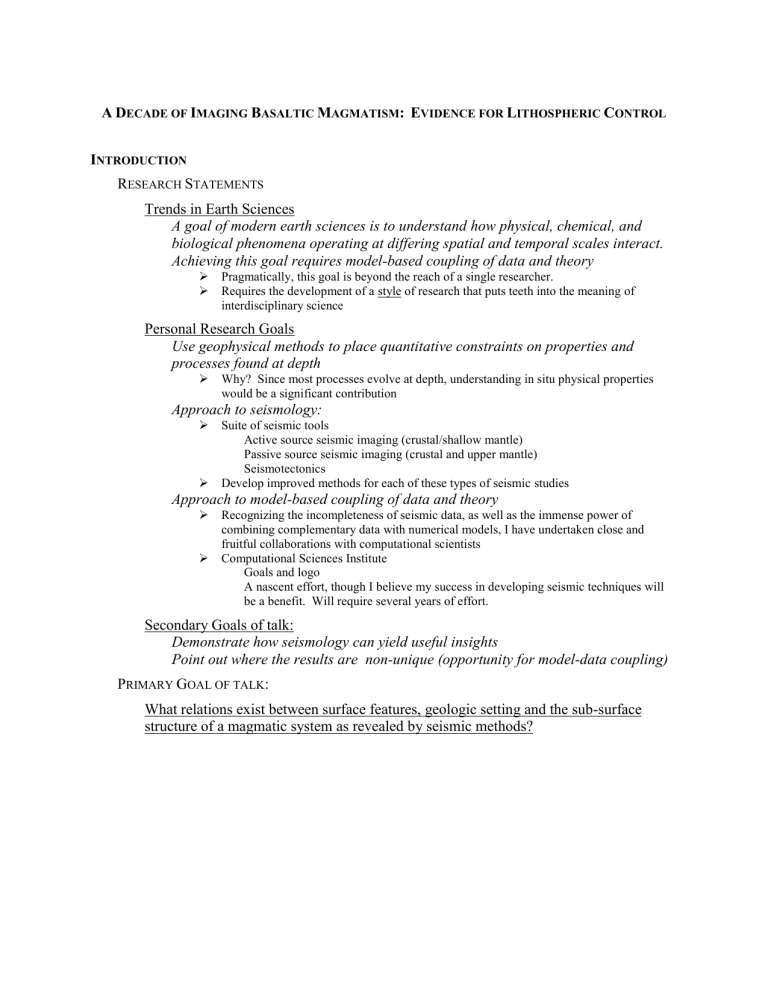
A D
ECADE OF
I
MAGING
B
ASALTIC
M
AGMATISM
: E
VIDENCE FOR
L
ITHOSPHERIC
C
ONTROL
I NTRODUCTION
R ESEARCH S TATEMENTS
Trends in Earth Sciences
A goal of modern earth sciences is to understand how physical, chemical, and biological phenomena operating at differing spatial and temporal scales interact.
Achieving this goal requires model-based coupling of data and theory
Pragmatically, this goal is beyond the reach of a single researcher.
Requires the development of a style of research that puts teeth into the meaning of interdisciplinary science
Personal Research Goals
Use geophysical methods to place quantitative constraints on properties and processes found at depth
Why? Since most processes evolve at depth, understanding in situ physical properties would be a significant contribution
Approach to seismology:
Suite of seismic tools
Active source seismic imaging (crustal/shallow mantle)
Passive source seismic imaging (crustal and upper mantle)
Seismotectonics
Develop improved methods for each of these types of seismic studies
Approach to model-based coupling of data and theory
Recognizing the incompleteness of seismic data, as well as the immense power of combining complementary data with numerical models, I have undertaken close and fruitful collaborations with computational scientists
Computational Sciences Institute
Goals and logo
A nascent effort, though I believe my success in developing seismic techniques will be a benefit. Will require several years of effort.
Secondary Goals of talk:
Demonstrate how seismology can yield useful insights
Point out where the results are non-unique (opportunity for model-data coupling)
P
RIMARY
G
OAL OF TALK
:
What relations exist between surface features, geologic setting and the sub-surface structure of a magmatic system as revealed by seismic methods?
F
AST
S
PREADING
R
IDGES
M
ANTLE STRUCTURE
What are our working models? What are some of the questions?
Where is melt generated and how is it focussed? What is the pattern of mantle flow?
Dynamic upwelling
Passive upwelling
Seismic effects of melt
Magnitude and pattern of predicted delays
P and S wave signatures
Observations
Delay time patterns
Isotropic tomography
DWS
Resolution tests
Squeezing
Results
Effects of mantle flow
Magnitude and pattern of predicted delays
P and S wave signatures
Observations
Delay time patterns
Anisotropic tomography
Synthetic inversions
Inversions of real data
Summary
Melt is broadly distributed(seismically)
Ice Melt Results
Anisotropy is a significant component of the signal (non-unique, requires combining data with theory)
S
HALLOW MANTLE STRUCTURE
What are our working models? What are some of the questions?
How is melt delivered from the mantle to the crust? Is there a relation between melt transport at mantle depths and surficial processes? Top down or bottom up?
Central supply
Distributed replenishment
Mantle diapirs
EPR 9 30’
Observations
Definition of Pn
Examples of data
Magnitude of signal
Tomographic Imaging
Heterogeneity
Anisotropy
Forward modeling of mantle flow
2D symmetric
2D asymmetric
Mantle diapirs
Summary
Results are consistent with Distributed Replenishment
C
RUSTAL STRUCTURE
What are the working models? What are some of the questions?
Crustal magma chambers: What are they?
How is the lower crust formed?
What controls the width of a magmatic system?
Axial segmentation: what causes it?
EPR 9 30’N
Observations
Delay time patterns with depth
Delay time patterns by rise crossing point
Tomographic Imaging
Cross-sectional structure
Rise-parallel structure
Physical Properties
Thermal structure
Melt Fraction
Volume of melt per depth
Summary
Presentation of Model
Cross-sectional cartoon
Rise-parallel cartoon
Correlation of seismic imaging with other parameters Results are consistent with
Distributed Replenishment
Magnetics
Petrology
Morphology
S
LOW
S
PREADING
R
IDGES
: 35 N
C
URRENT KNOWLEDGE AND WORKING MODELS
Magmatic, tectonic, thermal segmentation
Observations
Bathymetry and Gravity
Seismicity (brittle ductile transition)
Predicted effects of plate boundary geometry on thermal structure (melting region)
M ANTLE AND SHALLOW MANTLE STRUCTURE
Nothing is known about the upper 100 km of the mantle
Until recently, little was known about the shallow mantle
C RUSTAL STRUCTURE
What are the working models? What are some of the questions?
Similar questions, considerably less sophisticated models
MAR 35 N
Segment scale structure
Crustal thickness
Crustal lithology
Heterogeneity
Segment center structure
Crustal magma plumbing from tomographic imaging: transition from predominantly pipelike to rift parallel anomalies.
Shallow crustal structure
Evidence for shallow crustal magma bodies, within the lithosphere.
Lithospheric structure
Seismicity at 35 N: Maximum depth correlates with transition in velocity structure
Comparison with other slow-spreading ridge segments; segment center versus segment ends; rift valley relief versus maximum depth of seismicity.
S
UMMARY
:
Cartoons
S
UMMARY
M
AGMATISM AND FAST AND SLOW
-
SPREADING RIDGES
:
LITHOSPHERIC
C
ONTROL
?
Fast cartoon
Slow cartoon
O
VER
54
OVERHEADS
!!

